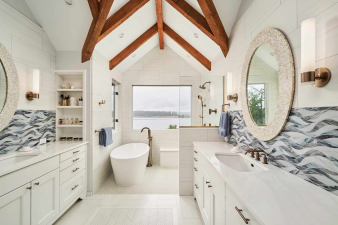Living in a small space can be both a challenge and an opportunity for creativity. When it comes to small living rooms, selecting the right furniture is crucial to maximize functionality without sacrificing style. The right choices can make your living area feel more spacious, organized, and inviting.

Understanding the Challenges of Small Living Rooms
1. Limited Space
Small living rooms typically offer limited square footage, which means every piece of furniture must be chosen carefully to avoid overcrowding. Therefore, understanding the dimensions of your space is essential.
2. Functionality
With limited space, furniture must serve multiple purposes. You need to prioritize items that not only meet your aesthetic preferences but also enhance the functionality of the space.
3. Aesthetics vs. Practicality
Balancing aesthetics with practicality is crucial. While you may want stylish decor, it should not come at the expense of comfort or usability.
Tips for Choosing the Right Furniture
1. Measure Your Space
Before making any purchases, measure your living room thoroughly. Note the dimensions of walls, doorways, and any architectural features such as windows, columns, or beams. Having accurate measurements allows you to select furniture that fits comfortably within your space.
a. Create a Floor Plan
Sketch a simple floor plan or use online tools to visualize how different furniture arrangements can affect the flow of your living room. This will aid in making educated decisions about the size and placement of furniture.
2. Prioritize Scale
Choosing furniture that complements the scale of your living room is key. Oversized furniture can overwhelm a small area, making it feel cramped. Conversely, too-small pieces may look disjointed and fail to provide the comfort you need.
a. Select Smaller Profiles
Look for furniture with slim profiles, such as thinner armrests, minimalist design features, and tapered legs. These types of pieces create an open feel while still offering the comfort you desire.
b. Consider Height
Pieces with low profiles, such as a low-slung sofa or coffee table, can make ceilings feel higher and the space feel more open. Avoid tall furniture that can enclose the room visually.
3. Embrace Multifunctional Furniture
In a small living room, multifunctional furniture can be a game changer. Here are some ideas to consider:
a. Sofa Beds
A sofa bed serves as both a stylish couch for lounging and a comfortable sleeping space for guests. Look for designs that blend well with your existing decor and take up minimal space when not in use.
b. Ottoman Storage
Ottomans that double as storage can be an excellent addition to a small living room. They can be used as footrests, additional seating, or even as a coffee table while providing hidden storage for blankets or games.
c. Nesting Tables
Nesting tables can be pulled out when needed and tucked away when not in use. This provides versatility and keeps your floor space clear during smaller gatherings.
d. Extendable Dining Tables
If your small living room includes a dining area, consider an extendable table that can be shrunk for everyday use and expanded for larger gatherings.
4. Choose Light and Bright Colors
The color palette in a small living room can significantly influence the perception of space.
a. Use Light Colors
Opt for light colors on your furniture, walls, and decor. Shades like white, beige, pastel, or soft grays reflect light, making the space feel larger and airier.
b. Incorporate Mirrors
Using mirrors strategically in your small living room can create the illusion of depth and openness. Consider mirrored furniture or wall-mounted mirrors to enhance the light and space.
5. Focus on Arrangement
The arrangement of your furniture is equally essential in maximizing space. Consider the following tips:
a. Create a Focal Point
Select a focal point for the room, such as a television, fireplace, or a piece of artwork. Arrange your seating to direct attention toward this focal point to create a cohesive and inviting atmosphere.
b. Optimize Traffic Flow
Ensure there is a clear path for movement in the room. Avoid placing large furniture in high-traffic areas, and aim to create walkways that make the space feel more open.
c. Use Angled Arrangements
If the shape of your living room allows for it, consider angling your furniture. This can create a dynamic flow and add interest without compromising space.

6. Incorporate Vertical Space
In small living rooms, vertical space often goes underutilized. Here are ways to make the most of it:
a. Tall Bookcases
Use tall bookcases or shelving units to draw the eye upward. This not only provides valuable storage but also helps give the illusion of higher ceilings.
b. Wall-Mounted Storage
Consider wall-mounted shelves or cabinets to keep items off the floor. This can free up space while providing convenient storage options.
7. Select the Right Sofa
The sofa is often the centerpiece of the living room, and selecting the right one is essential for creating a comfortable atmosphere in a small space.
a. Choose a Loveseat
If your small living room cannot accommodate a full-sized sofa, consider a loveseat or a two-seater couch. These options provide seating without overwhelming the space.
b. Modular Sofas
Modular sofas allow you to rearrange components for different needs and can fit into various spaces. Choose designs that offer configurability based on your requirements.
8. Add Accessory Options
Accessorizing your small living room can enhance its functionality and style. Here are some accessory options to consider:
a. Throw Pillows and Blankets
Adding decorative throw pillows and blankets can bring texture and comfort to your seating area. Choose colors that complement your overall decor while also providing cozy accents.
b. Area Rugs
An area rug can define your seating area and enhance the overall look of your living room. Select a size that fits well within your space without overpowering it.
9. Keep it Tidy
Maintaining a clutter-free living room is especially crucial in smaller spaces. Here are some practical organization tips:
a. Use Baskets and Bins
Incorporate stylish baskets or bins to keep items organized and stored away. This not only keeps the area tidy but also adds to your decor aesthetic.
b. Limit Decorative Items
Choose a few key decorative pieces that resonate with you, rather than overloading the space with items. This allows you to keep the focus on your chosen style.
10. Personal Touches
Personalizing your small living room makes it feel homely and inviting. Use the following ideas to integrate personal touches into your decor:
a. Family Photos
Display family photos in stylish frames, either on shelves, tables, or as part of a gallery wall. This adds warmth and character to your living room.
b. Unique Artwork
Incorporate artwork that reflects your personality and taste. Mixed media pieces or local artists' works can add a special charm to your space.
Conclusion
Choosing the right furniture for a small living room requires thoughtful consideration and creativity. By measuring your space, selecting appropriate scale, embracing multifunctional options, and making use of vertical space, you can achieve a well-designed living area that feels both functional and stylish.
Remember to prioritize comfort and personalization as you select your furniture and decor elements. A cozy living room invites relaxation and enjoyment, making it the heart of your home. With the right furniture choices, you can turn even the smallest living spaces into welcoming retreats.



